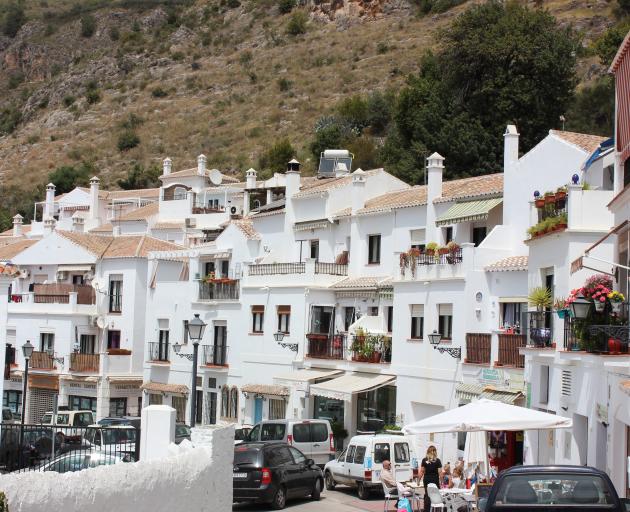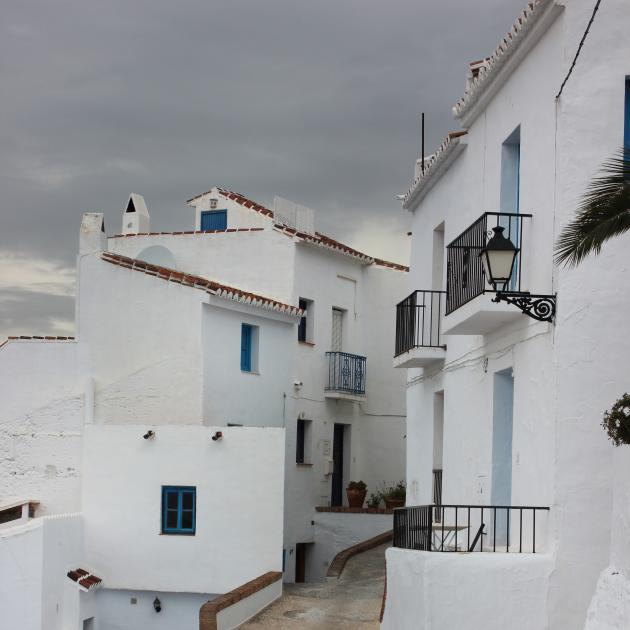
Andalusia has been practising a way of life for centuries, and has just about perfected the art, writes Julie Orr-Wilson.
As we rode the train south from Madrid my companion and I commended ourselves on heeding the good advice of friends: ''Don't rent a car''.
Speeding along at up to 300km an hour, past endless views of olive groves and grapevines, we could really relax.
Madrid had been fraught with the usual tourist traffic and auspicious gallery demands. Now we felt free to throw away the maps and tourist guides. Our trip was one of measured fairness. The template was the city, the countryside, and repeat, over the course of several weeks. A grand plan. Even the city lover came to appreciate the respite of out of the way places, even if the companion never came to fully appreciate city life.
I had chosen the hilltop village of Frigiliana, located at the base of the ''Natural Park'' of the Tejeda, Almijara and Alhama mountain ranges, simply because it is regarded as one of the most beautiful villages in Spain. The history stretches back to the Romans, its aquifers being the original attraction. Thanks to the Moors' legacy, the white-washed houses of Barrio Mudejar (referring to the neighbourhood's distinctive Arabic architectural style) spill down El Fuerte hilltop along tiny, steep, patterned cobbled streets, in breathtaking style.
Our English Airbnb host, Wendy, kindly collected us from the bus depot in Nerja, which saved us waiting for the bus to arrive. However, it also meant we were almost literally thrown out on to Calle Real, where we were to stay, as Wendy was unable to stop because of the narrowness of the streets. The traditional homely three-level accommodation, in the heart of the Mudejar, was surrounded by a mix of galleries, shops and residences.

Made up of 20 nationalities, the 3000 residents take great pride in the village. Whitewashed to perfection, each dwelling is individualised by a colourful front door, often decorated, along with plants in pots. Interestingly, I had my most rewarding encounter in the gallery of a Lithuanian native, where Tadas sold his wife's regional watercolours along with his photography prints. Art and artists abound.
It was peaceful considering it was just past Easter and, sadly, we'd missed the processions that take place during Holy Week. Six times the Virgin de Los Dolores is carried through the darkened streets, followed by the villagers bearing candles, all the women wearing black. It is said to be most moving and the highlight of Frigiliana's year.
Our visit to San Antonio church was rewarding, this beautiful space filled with the scent of lilies, red carnations and hydrangeas, surprisingly still fresh from the Easter parade.
We were too early for the annual ''running of the bulls'', which coincides with the festival of St Anthony. The 14th century Spanish tradition evolved from the tactics originally used by cattle men when herding their bulls to the market, to entice them into their pens. As the bulls run - usually six - young men cling to balcony rails to torment them with flags or capes. It is not for the bumble footed, as the paved streets are slippery. More than a dozen people have died in bull runs in Spain in the past 100 years.
Alastair Boyd in his book, Travels in the Mountains of Andalusia, captures beautifully the essence of Spanish life: ''Spain in general, and Andalusia in particular, teaches us that you can have no real communal life unless you have focal and celebratory events throughout the year, in which the large majority of people participate. That is because the only basis of community is not supposedly enlightened self-interest but actual shared experience. This is much assisted by the preservation of pre-industrial feasts and saints' days and by a due attention to the rhythm of the seasons''.
Missing the Spanish traditions didn't stop us adhering to the old Spanish proverb, ''Que bonito es no hacer nada, y descansar despues''.
''How beautiful it is to do nothing, and then rest afterward''. We knew we would never confess to friends that we had ''skipped the line'' to the Alhambra and happily took a virtual tour instead.
Even the roosters sleep late in Frigiliana. A morning walk before 9am brought not a sight or sound. Don't even think of going out for coffee or supplies before noon. Only the next-door fishmonger was on the job early, fresh with his catch. Tiny, pan-fried anchovies along with an espresso became our usual breakfast fare.

It was easy to fall into patterns and attachments, creating a rhythm, if rather shallow, mostly around food. We ate out. Iberian pork fillet with Pedro Ximenez sherry syrup and pumpkin and sugar cane honey parmentier from Restaurante El Mirador, which combined outstanding food with our favourite view. Pumpkin ravioli with date and almond in a blue cheese sauce. The tortilla espanola, potato omelette.
We ate in, taking to the rooftop deck for scenery and sun. From here we could see the Mediterranean: close enough for us. We were far from the fray of the endless condos we had been shocked to see lining the coast. Rick Stein's claim that, ''Spain's southern coast is over developed'', is rather restrained.
The little ''supermercados'' provided us with spring asparagus, strawberries, muscatels, bread and the most delicious goat's cheese; a tortas competena, cake made with olive oil, flour, sugar, almonds and cinnamon; while the bottles of chilled sangria, lined up, were a temptation to curb the heat.
Frigiliana is described as ''the jewel in the crown of Andalusia''. The famous Andalusian-born poet Garcia Lorca captured the magic of Andalusia in his, ''Poem of the Deep Song'', responding to the gypsy music, poetry and dance surrounding him.
Lorca suggests: ''The important thing in life is to let the years carry us along''. In Frigiliana we just let the days carry us along.
- Julie Orr-Wilson is a Dunedin-based writer.












